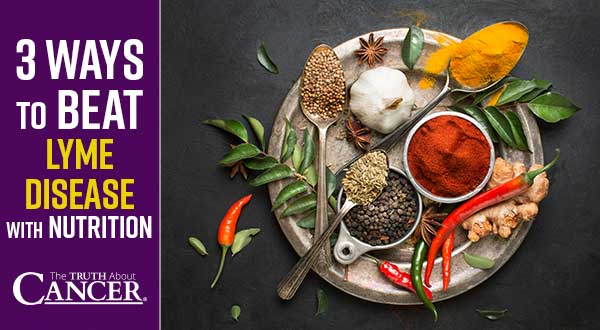The incidence of Lyme disease in the United States has doubled since the ‘90s, with nearly half a million people contracting the disease each year. Sadly, many Lyme patients can suffer long-term, chronic health issues. And while antibiotics and other pharmacological treatments can be effective, they often fall short.
The BEST way to keep your body healthy when dealing with Lyme disease is to support your body’s natural defenses with proper nutrition. Treatment with antibiotics alone may not completely eradicate the disease and can even lead to antibiotic-resistant cells that are even harder to combat. Studies have shown that herbal remedies can be MORE effective than drugs at beating the disease.
Fortunately, you can give your body a fighting chance against Lyme disease by following three nutritional guidelines that will help fight the bacteria and support your recovery. With these nutritional tips, you can live a happier, healthier life.
3 Ways to Fight Lyme With Nutrition
1 | Ditch the Junk Food
The foods you choose to eat can either help or hinder your recovery from Lyme disease by impacting your body’s inflammatory burden. The Standard American Diet, rich in refined carbohydrates and industrial seed oils, increases the expression of pro-inflammatory cytokines (immune molecules that trigger an inflammatory response).
Many of the same pro-inflammatory cytokines triggered by the SAD diet are also triggered by Lyme disease and other tick-borne infections. The SAD diet is also associated with an impaired immune response, which is the last thing you want when you’re battling an infection.
Before adding good foods to your diet, it’s essential to cut out the bad ones. Here are a few foods that should be avoided if you’re dealing with Lyme disease:
- Sugar
- Processed foods
- Trans-fats
- Refined carbohydrates (found in candy, enriched bread, pasta, cakes, and soda)
- Excessive alcohol
It’s best to look for natural, organic, limited-ingredient foods that will fuel your body rather than slow it down.
2 | Anti-inflammatory Foods
Once you clear out the troublemakers, you can begin to support your body with solid nourishment. Shifting your food focus to foods rich in nutrients and those with strong anti-inflammatory properties is a good strategy to support healing.
Rather than opt for “cheap” carbohydrates in the form of processed grains and sugars, choose complex carbohydrates in the form of cruciferous vegetables (broccoli, cauliflower, Brussels sprouts), leafy greens, fermented vegetables, and other cultured foods.
Some anti-inflammatory superstars include:
- Omega-3 fatty acids: Preclinical research indicates that the omega-3 fatty acids EPA and DHA can balance the inflammatory response in Lyme disease by impacting populations of immune signaling molecules. We recommend that Lyme patients consume at least 3-4 servings of fatty cold-water fish, preferably wild-caught, per week as a source of omega-3 fatty acids. When selecting seafood, use the acronym SMASH to remember which types of seafood are the most nutrient-dense and lowest in mercury – salmon, mackerel, anchovies, sardines, and herring.
- Cruciferous vegetables: Cruciferous vegetables such as broccoli and cauliflower provide sulforaphane, a phytochemical that reduces inflammation via the anti-inflammatory Nrf2 cellular signaling pathway. Activation of the Nrf2 pathway creates glutathione, which your body needs to manage Lyme-induced inflammation and mount a healthy immune response. Microgreen and broccoli sprouts are also an excellent source of sulforaphane and are easy and fun to grow at home.
- Fermented foods: Fermented foods such as sauerkraut and kimchi contain probiotic bacteria and other bioactive compounds that reduce gut inflammation and improve the immune system of the gut, which has significant effects on systemic immune function.
No anti-inflammatory diet would be complete without anti-inflammatory herbs and spices. Many contain antioxidant phenols that help block glycation and the formation of pro-inflammatory advanced glycation end-products, as well as aid in repairing intestinal damage linked to chronic inflammation.
Some of the top anti-inflammatory herbs & spices include:
- Cloves: This effervescent spice ranks among the most potent anti-inflammatory spices in the world, according to a study published in the Journal of Medicinal Foods.
- Ginger: One study suggests ginger is as strong and effective as many non-steroidal anti-inflammatory drugs, except without the harmful side effects!
- Turmeric (curcumin): This is one of the most powerful medicinal herbs on the planet, and one I believe belongs in everyone’s diet.
- Cinnamon: Cinnamon is loaded with powerful antioxidants and may lower blood sugar in people with diabetes.
- Oregano: Numerous compounds in this common cooking spice, including thymol and carvacrol, help reduce levels of pro-inflammatory cytokines.
- Marjoram: A study published in the American Journal of Chinese Medicine found that this tasty Mediterranean spice not only heals gastrointestinal ulcers but also repairs damaged intestinal walls. This is where pro-inflammatory substances enter the body and cause severe damage.
- Sage: Studies have shown that sage supports healthy immune function and exhibits potent anti-inflammatory properties. It’s also inherently anti-cancer!
3 | Fight With Fiber
High fiber foods help keep your intestinal tract healthy. Healthy digestion and good bowel function is critical when you are working to resolve Lyme disease (or any illness for that matter). The recommended daily intake of fiber from food is 25-30 grams.
Fiber is beneficial in regulating blood sugar levels and promoting regular bowel movements. Again, assisting the body with detoxification by eliminating wastes. If you are not eliminating with regularity you need more fiber in your diet. There are three things to consider when evaluating your fiber intake:
- Elimination is your body’s primary detoxification mechanism. When you poop, your body eliminates the byproducts of die-off and other metabolic waste. Normal bowel function consists of 1-3 well-formed, easily passed stools each day.
- Absorption is another critical factor. While water, some minerals, and alcohol can be absorbed in your stomach, most nutrients are absorbed in your small intestine. When the junctions between cells in the intestinal wall are damaged, it creates a condition known as “leaky gut,” or intestinal permeability. A leaky gut can allow toxins, microbes, and antibodies to escape from your intestines and travel throughout your body via your bloodstream.
- Immunity: Up to 80% of the immune system is located in the gut. In fact, the gut is often called the “second brain” because it interacts with hundreds of hormones in the body by way of beneficial bacteria. This is key information for individuals with Lyme disease, as we know that Lyme and co-infections can reside in the gut. Such an imbalance serves to further stress the immune system.
But fiber can be found abundantly in nature; you just have to know where to look. Nutrients for probiotic bacteria come in the form of certain kinds of fibers called “prebiotics.” Vegetables containing these fibers include:
- Artichokes
- Asparagus
- Garlic
- Onions
- Leeks
- Dandelion greens
Conclusion
Lyme disease can become a serious illness if left untreated. Since pharmaceutical interventions can fail – or even make the disease worse – it’s imperative that you support your body’s natural defenses with proper nutrition. By eliminating toxic, inflammatory foods, consuming nutrient-rich foods that combat inflammation, and obtaining the necessary fiber to support a healthy gut, you’ll be well on your way to regaining your health.
For more information about Lyme disease (and how you can reduce your risk), check out this article.
Editor’s Note: This article was initially published in 2021 and has been updated in 2025.



















After seeing the bulls eye and getting diagnosed, taking 30 days of antibiotics, still sick, I discovered spirolina and chlorella. Took these several times a day. Felt better in a week
In section 1\3 of the article “3 Ways to Beat Lyme Disease With Nutrition”, you list “saturated fats” among the junk foods to avoid. Is that a mistake? If I click on the link from “saturated fats” it explains that they are healthy foods, and it is other types of fats which should be avoided.
The article does not mention healthy saturated fats, it mentions trans fats which are man made and bad for you.
I don’t mean to be pessimistic, but nutrition doesn’t even begin to scratch the surface for those of us with complex Lyme situations. There’s way too much to even mention here, but many times there are hidden infections, typical & nontypical, at play with complex cases. And since testing these days to identify these hidden infections (including protozoa) is still subpar IMO, many of us have to be our own advocate resulting in continual research, while becoming even more hopeless as the years pass.
After many of us have exhausted our 401k and other funds in the past years (or decades in my case). So we no longer have funds at our disposal to use with the newer Lyme disease practitioners (ND, LLMD, etc.) who are more attuned to the complexities of the disease. And I for one don’t even have a practitioner in my area.